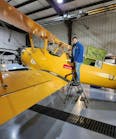As the chief instructor for Hillsboro Aviation in Oregon and a member of the U.S. Helicopter Safety Team (www.USHST.org), I am in a position to help shape (in a small way) the future of our helicopter industry. In a recent discussion with another helicopter safety professional, we concluded that there are no new ways to crash helicopters and that pilots are not using the strongest resources we have for learning how to avoid accidents: NTSB accident reports and other accident report summaries.
Sadly, I have known 16 people who have been killed in airplanes or helicopters in my short 10 years as a pilot. This is not a number I am proud of, but I have learned something from every one of these accidents. In all but two of these deaths, the pilots had the ability to change the outcome and as a result, every one of my students today learns how these pilots could have saved their own lives.
Industry statistics make it painfully clear that we are failing to ensure the pilots we train are learning the value of accident trends and causes. Too often, pilots are crashing helicopters and regretfully, the result is death. The simple truth is that virtually all of these accidents are avoidable and the causes are well known. In addition, as safety educators, we must teach our students to use all the resources available, learn from others’ mistakes and improve their education to become better pilots.
A simple action that can make this happen is developing a daily routine to read accident reports.
Many of the Certified Flight Instructors I know integrate the reading of incident reports into their students’ primary training. During critical times in a student’s training, we can develop the skills and practices they will carry forward into their lives as a student and private or professional pilot. We must take advantage of this critical time to get students excited about learning how to save lives. With this in mind, how should we teach our students so they can glean all the relevant information out of these reports?
First, we must get the reports and articles into our students’ hands. There are multiple ways to find information about helicopter accidents. Some that I use are the NTSB website, Google alerts, Helicopter Association International (HAI) daily emails, numerous helicopter industry news magazines, and accident coverage from newspapers and television reports.
Next, it is critical that our students and we as educators are in the proper mindset when we discuss the details of these reports. Many pilots display hazardous attitudes when reading about helicopter accidents, using phrases like, “I would never do that” or “Boy, he was dumb.” When reading these reports, it is essential to understand that the pilots are just like you or me. None of them started their day planning to have an accident. They allowed mistakes and situational factors to put them where they never should have been. We all can go back in our lives and careers and recall things we did which could have led us into the same traps. We were just lucky that in our situation, it worked out okay.
A student also must learn how to read the NTSB reports and the news articles about an accident. There often are very few facts offered and this leaves the reader to interpret and reconstruct the flight on their own. In addition, initial media reports sometimes get the facts wrong or jump to conclusions about the accident’s cause. The reader must decipher all this information to put together a mental image of this flight and where the breakdowns occurred. Students must be taught to see accident chains building and determine the points at which the pilot or crew could have turned things around and had a safe outcome. When out on a flight, if we can recognize these critical events starting to line up, we can change the outcome and make sure that we do not meet the same fate.
Finally, all pilots should develop their own risk mitigation plans for each accident they read about. What can be done before every flight to ensure a safe operation? The strategy should not change when there are time constraints or there is pressure, either internally or externally, to get something done. It helps to think about who could be affected by the pilot’s decision and actions, such as family, passengers and passengers’ families, who all trust the pilot to fly safely.
Luck does play a part in every flight. However, by arming ourselves with the knowledge of what has hurt or killed our fellow pilots, we can reduce the amount of luck involved in each flight. Knowledge about hazards, our plans to mitigate them, and the constant awareness of them will prevent us from dying because of them.
As an industry, we must work together to reduce our accident rate. No one else is going to do it for us. Every pilot must make it part of their daily routine to review accidents. It can be a small part of the day, but it is a critical investment. It requires constant education, training and awareness by each and every one of us. The only way we can change the next generation of pilots is to include this process now in their primary training.
Dan Doepker is the Chief Helicopter Instructor for Hillsboro Aero Academy (formerly Hillsboro Aviation). Dan is a dual rated pilot and certified flight instructor in both helicopters and airplanes. With a passion for safety, he volunteers his time on the United States Helicopter Safety Team (USHST) and the Helicopter Association International Training Committee.
